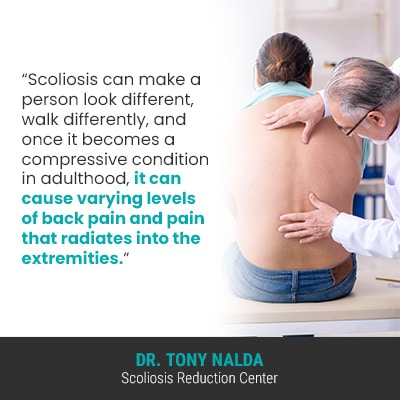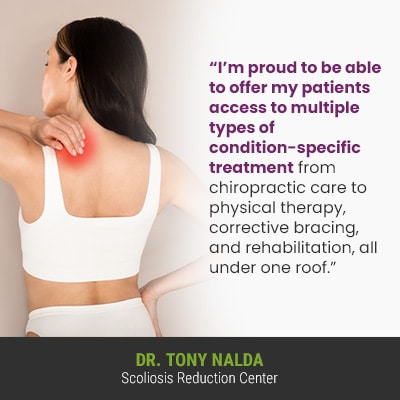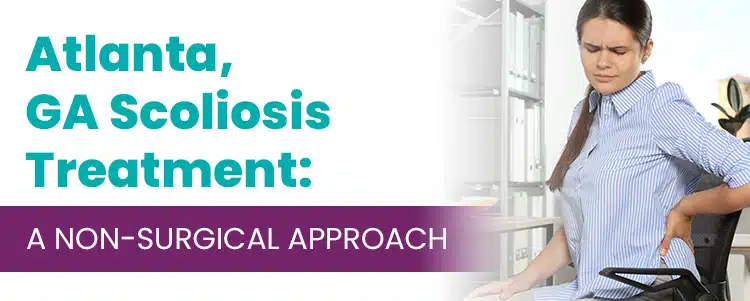Scoliosis is a highly-prevalent progressive spinal condition, and as such, it needs to be treated proactively. While there are different scoliosis treatment approaches, not all are created equal, and for those interested in a non-surgical treatment option, conservative chiropractic-centered treatment is precisely where one should start.
A mere 450 miles can be covered in a 7.5-hour drive, putting those in search of Atlanta, Georgia scoliosis treatment within reach of one of the world’s leading scoliosis chiropractors: Dr. Tony Nalda. Celebration, Florida is home to Dr. Tony’s renowned practice, the Scoliosis Reduction Center®.
Scoliosis can be a confusing condition to be diagnosed with. Not only does it range widely in severity, there are also multiple different condition types and ways to treat it.
Being Diagnosed with Scoliosis
Being diagnosed with scoliosis can be difficult news to process, particularly for young people who just want to fit in with their peers.
 Scoliosis can make a person look different, walk differently, and once it becomes a compressive condition in adulthood, it can cause varying levels of back pain and pain that radiates into the extremities.
Scoliosis can make a person look different, walk differently, and once it becomes a compressive condition in adulthood, it can cause varying levels of back pain and pain that radiates into the extremities.
A diagnosis of scoliosis is given when a person develops an unnatural sideways spinal curve that also rotates, and has a minimum Cobb angle measurement of at least 10 degrees.
A patient’s Cobb angle is determined during X-ray by drawing lines from the tops and bottoms of the curve’s most-tilted vertebrae, and the resulting angle is expressed in degrees and determines how severe a condition is:
- Mild scoliosis: Cobb angle measurement of between 10 and 25 degrees
- Moderate scoliosis: Cobb angle measurement of between 25 and 40 degrees
- Severe scoliosis: Cobb angle measurement of 40+ degrees
- Very-severe scoliosis: Cobb angle measurement of 80+ degrees
Scoliosis is Progressive
Being diagnosed with scoliosis also means the challenge of living with a condition whose nature is to worsen over time, particularly if left untreated, or not treated proactively.
The condition’s severity levels are also its progressive line, so even if a person is diagnosed with mild scoliosis, that’s not indicative of where the condition will stay.
Mild scoliosis can easily progress to moderate, severe, or very severe; only proactive treatment can work towards counteracting the condition’s progressive nature.
Scoliosis progressing means the unnatural spinal curve is getting larger, and this means more and more uneven forces are being introduced to the body, and the effects are going to become increasingly noticeable.
In addition, the spine is becoming more rigid, making it less responsive to treatment and more complex to treat.
In children and adolescents, the main symptom of scoliosis is postural deviation, and while each case is unique, some common postural changes caused by scoliosis can include:
- Uneven shoulders
- Uneven shoulder blades
- The development of a rib arch
- Uneven hips
- Arms and legs that appear to hang at different lengths
These postural changes are caused by the condition’s uneven forces disrupting the body’s overall symmetry, and additional signs of scoliosis can include clothing becoming ill-fitting, and changes to gait, balance, and coordination.
So for those in the Atlanta, Georgia area who have been recently diagnosed with scoliosis, did you know you’re only 450 miles away from world-class non-surgical scoliosis treatment?
Dr. Tony’s Scoliosis Reduction Center® is located in Celebration, Florida, so a 7.5-hour car drive, or a mere 1.5-hour flight, can mean accessing multiple forms of scoliosis treatment under one roof.
Before getting to the specifics of a proactive conservative treatment approach, let’s first explore what the dominant treatment choice was for many years: traditional scoliosis treatment.
Traditional Surgical Scoliosis Treatment
The traditional approach to scoliosis treatment funnels patients towards spinal fusion surgery, which can be a costly, invasive, and risky procedure.
While all surgical procedures come with their share of risks, spinal surgery can be particularly risky because the spine and brain work in tandem to form the body’s central nervous system.
The central nervous system is a vast communication network that facilitates brain-body communication, so the spine is involved in virtually every working system within the body, which is why spinal conditions can cause such a wide range of symptoms felt throughout.
Traditional scoliosis treatment doesn’t have a strategy for treating scoliosis while mild, even though this is the best time to treat scoliosis, so commonly recommends that patients merely watch and wait until their condition progresses to a certain point.
If a patient’s scoliosis progresses into the severe classification with a curvature size of 40+ degrees, this is considered severe scoliosis, and for those on the path of traditional treatment, they become surgical candidates.
Scoliosis surgery involves fusing the unnatural curve’s most-tilted vertebrae into one solid bone; the goal of this is to eliminate movement in the area, meaning the vertebrae can’t become more tilted (progression).
Spinal fusion also involves the removal of intervertebral discs; an intervertebral disc sits between adjacent vertebrae (bones of the spine).
The discs are key to the spine’s overall health and function as they facilitate flexible movement, provide the spine with structure, cushioning between adjacent vertebrae, and act as the spine’s shock absorbers; their removal is contrary to the spine’s natural design.
Once the vertebrae are fused, rods are commonly attached to the spine with pedicle screws so it is held in place, and hardware used is permanent.
If a patient has an adverse reaction to hardware, or there is a hardware malfunction (rod cracking, screw coming loose), there is no recourse other than subsequent surgeries.
The spine being held in place by artificial means is not the same as working towards corrective results through a more natural non-surgical treatment approach, and can cost the spine in terms of its overall health, strength, and function.
Many patients are disappointed with their loss of spinal flexibility and range of motion post-surgery.
Conservative Non-Surgical Scoliosis Treatment
Here at the Center, I offer patients a modern alternative to scoliosis surgery: proactive conservative non-surgical treatment.
Being proactive means starting treatment as close to the time of diagnosis as possible.
While there are never treatment guarantees, early detection and intervention does increase the likelihood of treatment success, and working towards preventing progression can mean avoiding the development of certain symptoms; it’s far simpler to avoid developing related complications, than to attempt to reverse them once they’ve occurred.
 I’m proud to be able to offer my patients access to multiple types of condition-specific treatment from chiropractic care to physical therapy, corrective bracing, and rehabilitation, all under one roof.
I’m proud to be able to offer my patients access to multiple types of condition-specific treatment from chiropractic care to physical therapy, corrective bracing, and rehabilitation, all under one roof.
Not everyone has the means of traversing multiple offices and clinics to access these different levels of care, but here at the Center, they are accessible and complement one another to impact scoliosis on every level.
Conclusion
So for residents of Atlanta, Georgia wanting to forgo a surgical recommendation, or who simply want to try a more natural less-invasive form of treatment first, Dr. Tony Nalda is a mere 1.5-hour flight, or a 7.5-hour drive away.
By focusing on chiropractic care, as a structural condition, scoliosis can be impacted where it needs to be the most: on a structural level.
Through a series of chiropractic techniques and manual adjustments, I can work towards readjusting the position of the curve’s most-tilted vertebrae back into alignment with the rest of the spine, thereby reducing the curve.
Physical therapy is also essential as increasing the spine’s surrounding muscle strength can mean providing it with optimal support and stabilization.
Corrective bracing can be particularly effective on growing spines and can help achieve corrective results by pushing the spine into a corrective position.
Through a series of custom-prescribed scoliosis-specific exercises and stretches, I can help patients establish a home-rehabilitation program to further stabilize the spine.
So don’t hesitate to reach out for guidance and support; it can set you, or someone you care about, on the path of proactive treatment and an improved quality of life.




